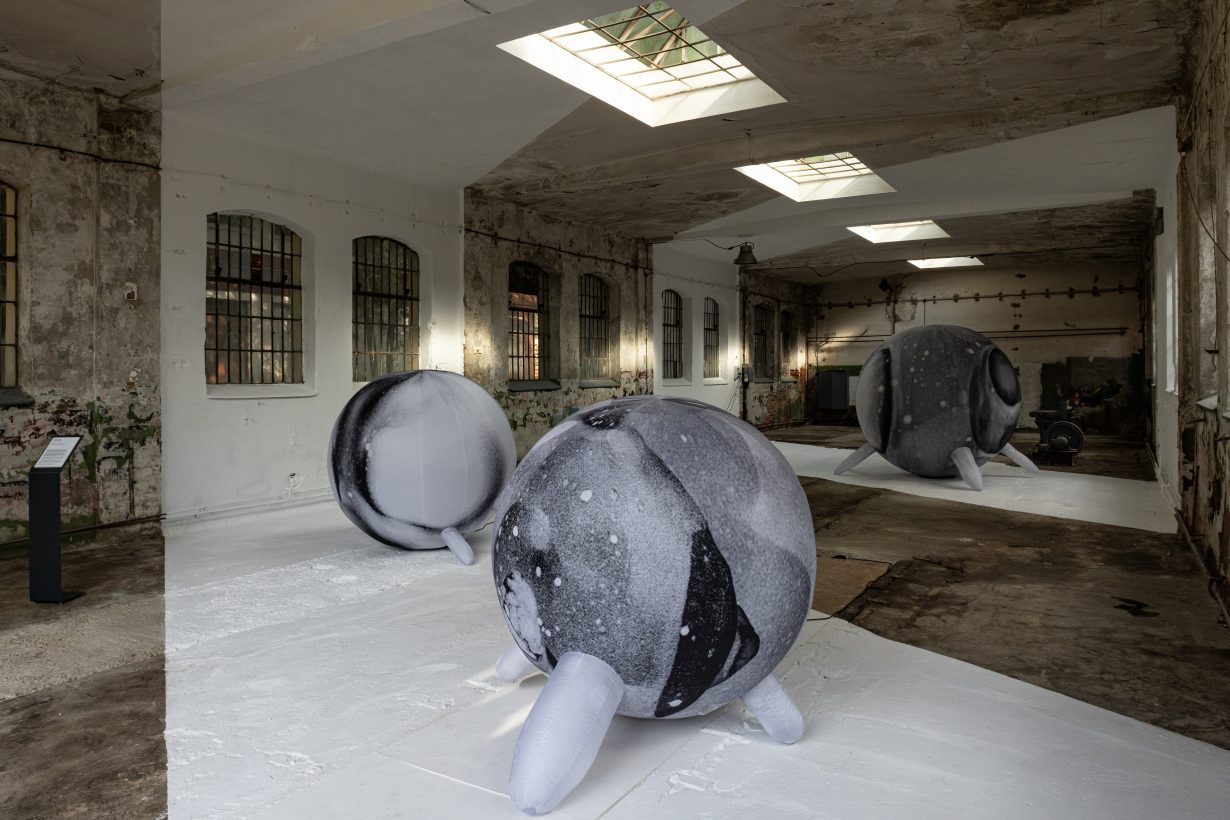The latest edition, My Rhino is Not a Myth: art science fictions, asks us to imagine the possibilities of transhumanism and posthumanism
In the disused transport depot of Timișoara, western Romania, three large inflatable textile sculptures by Anetta Mona Chişa, which mimic the shape of nuclear atoms, describe their own demise. From hidden speakers, a high-pitched childlike voice, purporting to be that of ununennium, a hypothetical element not yet fully catalogued on the periodic table, narrates some sort of Armageddon situation. Across the overgrown yard, inside one of the rusting old maroon- and-beige city trams, is another series of sculptures, these ones by Cristian Răduță, in which the passengers and drivers of the vehicle have been replaced by oversize mutant animals crudely assembled out of card, tape and haphazard found materials. A spindly-legged bird, a big yellow dog, a humanoid rabbit wearing boxing gloves – given the dereliction of the yard, the decay of the vehicle and their Frankenstein form, together they inhabit the vehicle like the last survivors of some terrible trauma.
Chişa’s Ununennium’s dream* (2023) and Răduță’s The Diamond Hunters (2019) are entry points to the themes of Art Encounters Biennial – this year overseen by Swiss curator Adrian Notz – in which doomed humanity, object oriented ontology (OOO) and what might be thought of as ‘known unknowns’ of science prove thematic focal points. These have, at least in Europe and the Americas, been curatorial mainstays for a decade now (though OOO owes a lot to far more ancient ideas of animism), trickling down from the much-imbibed writings of Graham Harman, Timothy Morton, Donna Haraway and others, into major exhibitions on the art-circuit calendar (Carolyn Christov-Bakargiev’s Documenta 13, in 2012, for example), and now, the cynic might argue, they reach Romania’s fifth city in time for its European Capital of Culture celebrations as a kind of art-theory brand. There are works here that might fit this jaded view, given their biennial-circuit ubiquity: Zheng Bo’s Pteridophilia (2016–21), for example – a series of films presented across town on monitors nestled among potted foliage, in which young men engage in variously sexualised and romantic entanglements with forest flora – has been exhaustively shown.

The exhibition’s title, My Rhino is Not a Myth, is a reference to Albrecht Dürer’s woodcut rhinoceros (created 1515, famously before Dürer had seen the animal himself, a print is on display and the image adorns all the exhibition signage), and in the main the show counters initial doomist concerns by asking us to imagine the possibilities of transhumanism and posthumanism. Imagery of the end times still pervades: it is a pessimism present in Mizanur Rahman Chowdhury’s Waiting for the Becoming Song (2023), an installation of various random objects (including car seats, piles of bottled water, towers of electricals) the artist assembled during his time spent in Timișoara. A couple of old TVs among this junk are showing live rolling news, which on my visit is reporting an explosion at a chemicals factory in China and dust storms in America: stark warnings about wanton consumption and impending environmental disaster. That is played with too in Saša Tkačenko’s Celebrating Ruins (2018), a pile of bent metal and debris (with a snaking strip of neon woven in and out) similarly scavenged, and made abundantly clear in Dimitar Solakov’s Exodus (2022) paintings, which show a rocket leaving burning Earth. It’s pretty depressing stuff, but glimmers of hope can be found.
That survives in Giulia Crețulescu’s series of wearable (but wall-mounted) textile works, which have the look of something between stab vests and parachute packs, but posit the adaptability of the body in their added padded protection and the multiple straps offering prosthetic enhancement. Faint hope is found too, with more manipulated bodies, in Hortensia Mi Kafchin’s gratifyingly weird postapocalyptic paintings in which life survives, albeit not as we know it. Deformed figures roam an acid-coloured landscape (one work is titled Spring in Chernobyl, 2019). Optimism too in Maren Dagny Juell’s Monument For A Sim Inventory. What. We. Bring. Home (2023), a stack of random motifs in uniform, white fibreglass situated in a busy public square, which we are told, in an accompanying plaque, imagines extraterrestrial refugee humans returning to Earth to collect things needed for its digital remaking. It might be a stretch to arrive at this narrative without the interpretation, but the sculpture nonetheless feels an alien presence as shoppers and drinkers mill around it.
Yet a show highlight suggests that maybe our best hope, our saviour aliens – or at least those traditionally alienated – are living here among us. Naomi Rincón Gallardo’s Opossum Resilience (2019) retells Mesoamerican myths of parallel worlds and times, through jaunty song and lavishly outlandish theatre in the desert. It’s a formally seductive film – an ode to queer indigenous spirit – that posits how the world might survive if only the Eurocentric thinking, dominant since Dürer and the Renaissance, gives way to another way of being.
My Rhino is Not a Myth: art science fictions, Various venues, Timi̦soara, 19 May – 16 July
